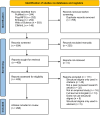The use and operationalization of "structural stigma" in health-related research: A scoping review
- PMID: 39736593
- PMCID: PMC11684274
- DOI: 10.1186/s12889-024-21171-8
The use and operationalization of "structural stigma" in health-related research: A scoping review
Abstract
Background: Research that investigates the negative health effects of stigma beyond the individual and interpersonal levels is increasingly using the concept of "structural stigma." This scoping review investigates how the concept of "structural stigma" has been used and operationalized in health-related literature to date in order to characterize its usage and inform future operationalizations.
Methods: A systematic search and screening process identified peer-reviewed, English-language research articles that used the term "structural stigma" available prior to January 1, 2024 in five databases (i.e., PubMed, PsycINFO, Embase, Web of Science, CINAHL).
Results: Of the 298 articles identified, over half (53%) were published from 2021 onward. Articles most commonly were set in the United States (n = 163, 55%), investigated stigma toward sexual minority people (n = 163, 55%), and cited the introduction of a special issue of Social Science & Medicine as their source of the concept (n = 84, 28%). Most articles (64%) used at least one additional conceptual framework, most commonly minority stress theory (n = 107, 36%). Quantitative operationalizations (n = 102) engaged most in the conceptual domain of laws and government-level policies, while qualitative operationalizations (n = 68) engaged most with institutional (i.e., non-government-level) policies, practices, and procedures.
Conclusions: As the use of "structural stigma" is increasing, operationalizations can better leverage the concept's breadth and account for individuals' intersectional lived experiences. This will necessitate bridging across methodologies and bodies of research on related negative social processes.
Keywords: Discrimination; Qualitative; Quantitative; Scoping review; Stigma; Structural factors.
© 2024. The Author(s).
Conflict of interest statement
Declarations. Ethics approval and consent to participate: Not applicable. Consent for publication: Not applicable. Competing interests: The authors declare no competing interests.
Figures
References
-
- Du Bois WEB. The Philadelphia Negro: a social study. Reprint edition. Philadelphia: University of Pennsylvania; 1996.
-
- Diez Roux AV. Ecological variables, ecological studies, and multilevel studies in public health research. In: Detels R, Gulliford M, Abdool Karim Q, Tan CC, editors. Oxford textbook of global public health. Sixth edition. Oxford: Oxford University Press; 2017.
Publication types
MeSH terms
Grants and funding
LinkOut - more resources
Full Text Sources
Research Materials




